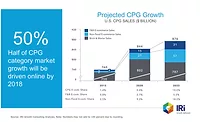Supercenters, eCommerce give opportunity to mass merchandisers
Wal-Mart offers free pickup for orders made online or through mobile app
The world of retail is ever-changing, and retailers continually have to innovate and adapt to the changing times and consumer. According to Barrington, Ill.-based Willard Bishop’s “The Future of Food Retailing, 2015,” report, sales of consumables in the mass merchandising channel have declined. “The Mass format experienced a slight decline this year of 1.2 percent to $47.9 billion and a 6.3 percent decline in store count to a little over 3,000 stores,” the report states. With a decline in consumable sales, innovation will become essential.
Susan Viamari, vice president of thought leadership at Chicago-based Information Resources Inc. (IRI), notes that while beverage dollar sales as a whole grew
3 percent during the past year in grocery, dollar and club stores, in the mass merchandiser channel, it dropped 11.2 percent.
Yet, Eric Penicka, U.S. analyst for Chicago-based Euromonitor International, notes that bulk water, among other bulk-product sales, has benefited mass merchandisers. “[B]e it large pack sizes or multipacks, both abundant in mass merchandisers, appeal to cost-conscious consumers,” he says.
Additionally, Tim Barrett, retail analyst at Euromonitor, notes that mass-merchandiser shoppers generally are buying in larger packs and containers, as opposed to single-serve cans or small packs.
Supercenters to the rescue
Despite the losses, the mass merchandiser’s big brother, the supercenter, could be the saving grace for the channel. “Supercenters have steadily grown in their consumables in the past year or so, i.e., 3.6 percent in 2014,” says Jon Hauptman, partner at Willard Bishop. “However, the traditional mass-merchandiser format experienced a slight decline of 1.2 percent in consumable sales during that same time, demonstrating that there is still room to build more supercenters.”
In 2014, supercenter sales grew at a steady pace of 3.6 percent to $207.5 billion, according to Willard Bishop’s report. The market research firm also estimates that supercenter sales will grow at a rate of 2.9 percent a year into 2019, while mass merchandisers will continue experiencing sales declines of 3 percent during that same timeframe.
“I think the future is bright for supercenters, while we’ll see traditional mass merchandiser growth continue to wane,” Hauptman says. “It appears that the key to success of a mass merchandiser is having a robust assortment of food items to drive trips.”
IRI’s Viamari notes that innovation is crucial to the channel’s future. “The mass merchandise channel will need to continue to evolve to meet consumers’ changing needs,” she says. “High growth segments — such as millennials, Hispanics, non-traditional families — are key targets. They shop differently from each other and from ‘traditional’ shoppers. Mass merchandisers will need to invest to understand these shoppers and to stay on top of their needs/wants as their life stages change.”
eCommerce upswing
As mass merchandisers search for ways to appeal to U.S. consumers, more have noted one trend to which they are flocking — eCommerce. Willard Bishop’s report shows a 13.5 percent growth in eCommerce sales, while mass merchandisers saw a decrease of 1.2 percent for the same time period.
“ECommerce sales for food and consumables increased by 13.5 percent in 2014 to $24.4 billion,” the report states. “However, more and more brick-and-mortar grocery retailers … are stepping up their eCommerce efforts and trying to steal market share away from pure play retailers.”
Euromonitor’s Barrett anticipates that the click-and-collect model will proliferate in the United States.
One example of click-and-collect is Bentonville, Ariz.-based Wal-Mart Stores Inc.’s drive-up order pickup for consumers shopping via walmart.com or the Wal-Mart mobile app in select markets. “Customers can simply shop their grocery lists online, choose a time to pick up their orders and then pull into a designated parking area at their local stores, where associates will load the items into their cars,” explained Michael Bender, executive vice president and chief operating officer of Wal-Mart Global eCommerce, in a September blog post.
“We’ve tested online grocery options — both pickup and delivery — in a handful of markets across the U.S., and each time we’ve added a new city, our customers begin using the service faster than they did in the previous one,” Bender said.
“With 70 percent of the U.S. population living within 5 miles of an existing Walmart store, this is an idea that simply makes sense for us,” he adds. “We have the locations already in place, and with our website and mobile app expertise, we’re able to combine those things in a way that helps our customers save time and still take advantage of our everyday low prices.”
The service not only caters to those who prefer eCommerce as their method of shopping, but also those who are looking for the in-and-out, quick-trip. “Mass merchandisers are working to fight off inroads from competing channels…Two-thirds of trips are ‘quick trip’ missions — meaning consumers are going specifically to pick up a few ’need now’ types of products,” IRI’s Viamari explains. “Consumers are looking to get in and out of the store quickly.”
Looking for a reprint of this article?
From high-res PDFs to custom plaques, order your copy today!




